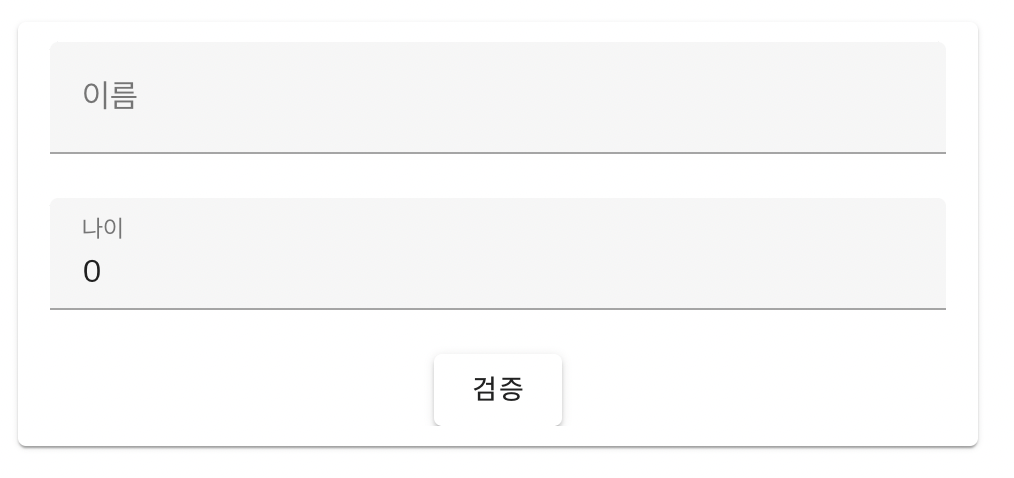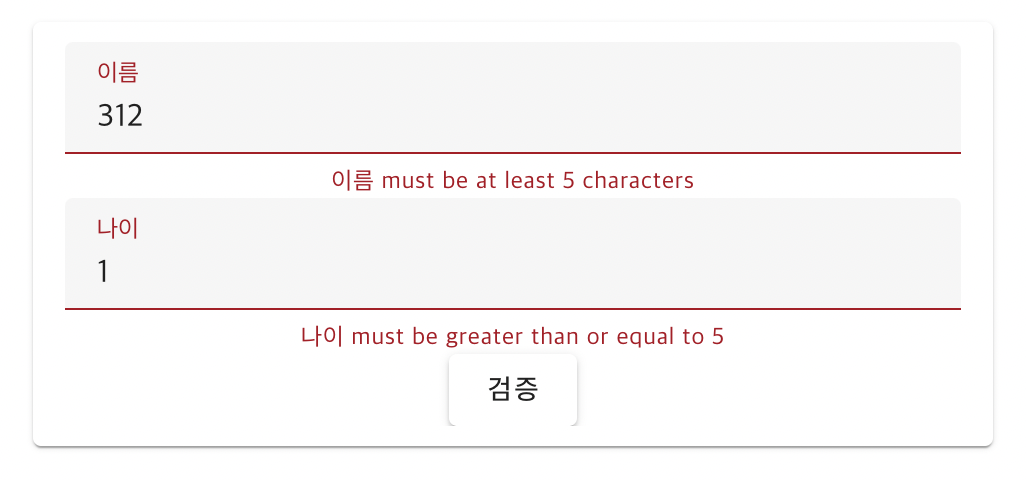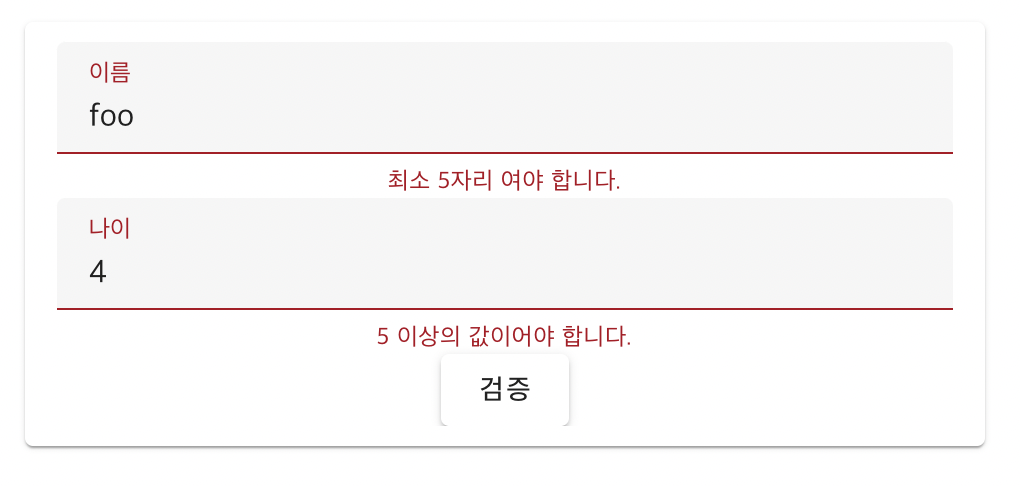개요
- 프론트에서도 입력값에 대한 검증을 하기 위해 vee-validate와 yup을 사용했습니다.
- vee-validate는 vue.js에서 form validation을 편하게 해주는 도구입니다.
- yup은 유효성 검사를 위한 스키마 빌더입니다.
- vuetify가 기본으로 제공하는 rules로도 유효성 검사를 할 수 있지만 일일히 rules를 만들기 복잡하고 관리하기 어렵기 때문에 vee-validate와 yup을 통해 유효성 검사를 간편하게 해보겠습니다.
- 기본적인 사용법과 vuetify랑 같이 사용하는 방법을 알아보겠습니다.
환경
"devDependencies": {
"nuxt": "^3.0.0-rc.6"
},
"dependencies": {
"@mdi/font": "^6.9.96",
"axios": "^0.27.2",
"nuxi": "^3.0.0-rc.6",
"sass": "^1.53.0",
"vee-validate": "^4.6.4",
"vuetify": "^3.0.0-beta.7",
"yup": "^0.32.11"
}
vee-validate & yup 설치
yarn add vee-validate
yarn add yup
- v4 이상의 vee-validate를 의존성 추가 해줍니다.
사용할 UI

<template>
<v-container align="center">
<v-card max-width="480px">
<v-card-item>
<v-form>
<v-text-field v-model="name" label="이름"></v-text-field>
<v-text-field v-model="age" label="나이"></v-text-field>
<v-btn type="submit">검증</v-btn>
</v-form>
</v-card-item>
</v-card>
</v-container>
</template>
<script setup lang="ts">
const name = ref("");
const age = ref(0);
</script>
vee-validation & yup 사용
- vee-validate에는 컴포넌트 방식과 컴포지션 API 방식 두가지 방법으로 유효성 검증을 할 수 있습니다.
- 그 중 Form과 Field를 이용한 컴포넌트 방식을 이용하여 유효성 검증을 해보겠습니다.
<template>
<v-container align="center">
<v-card max-width="480px">
<v-card-item>
<Form as="v-form" :validation-schema="schema" @submit="onSubmit">
<Field name="name" type="text" v-slot="{ handleChange, errors }">
<v-text-field
v-model="name"
@update:modelValue="handleChange"
label="이름"
:error-messages="errors"
/>
</Field>
<Field name="age" type="number" v-slot="{ handleChange, errors }">
<v-text-field
type="number"
v-model="age"
@update:modelValue="handleChange"
label="나이"
:error-messages="errors"
/>
</Field>
<v-btn type="submit">검증</v-btn>
</Form>
</v-card-item>
</v-card>
</v-container>
</template>
<script setup lang="ts">
import { Form, Field } from "vee-validate";
import * as yup from "yup";
const name = ref("");
const age = ref(0);
const schema = yup.object({
name: yup.string().required().label("이름").min(5),
age: yup.number().required().label("나이").min(5),
});
const onSubmit = () => {
console.log("hello");
};
</script>
- Form에는 yup으로 생성한 오브젝트 스키마에 대한 값이 들어가야합니다.
- Field 컴포넌트를 이용하여 위와 같이 유효성 검증을 할 수 있습니다.
- name에는 yup으로 생성한 오브젝트 스키마의 필드명이 들어가야 합니다.
유효성 검증을 위한 컴포넌트 추가
- Field 컴포넌트를 이용하여 하나씩 설정을 하기에는 반복되는 부분도 많고 복잡하기 때문에 검증을 위한 컴포넌트를 작성하여 사용해보겠습니다.
- nuxt의 경우 components 폴더 아래 Vue 컴포넌트를 작성한다면 다른 페이지에서 import 하지 않고 사용할 수 있습니다.
// /components/TextFieldWithValidation.vue
<template>
<v-text-field
v-model="value"
@blur="handleBlur"
:label="label"
:error-messages="errors"
:type="type"
/>
</template>
<script setup>
import { defineProps, toRef } from "vue";
import { useField } from "vee-validate";
const props = defineProps({
name: {
type: String,
requird: true,
},
type: {
type: String,
requird: true,
},
label: {
type: String,
required: true,
},
});
const { value, handleBlur, errors } = useField(toRef(props, "name"), undefined);
</script>
- components 폴더 아래 유효성 검증을 위한 컴포넌트를 작성해줍니다.
<Form as="v-form" :validation-schema="schema" @submit="onSubmit">
<TextFieldWithValidation
v-model="name"
name="name"
label="이름"
/>
<TextFieldWithValidation
v-model="age"
type="number"
name="age"
label="나이"
/>
<v-btn type="submit">검증</v-btn>
</Form>
- Form에 대한 코드를 이전보다 간소하게 작성할 수 있습니다.
- 컴포넌트의 name에는 yup.object로 생성한 스키마의 필드명이 들어가야합니다.
에러 메시지 언어 설정

- yup.object를 이용하여 개별 설정도 할 수 있지만 컴포넌트가 많다면 setLocale을 이용하여 스키마 타입에 따라 설정할 수 있습니다.
- 설정 파일의 경우 nuxt의 plugins 폴더 아래 위치하면 자동으로 등록됩니다.
// /plugins/yup.ts
import { setLocale } from "yup";
export default defineNuxtPlugin((nuxtApp) => {
setLocale({
string: {
min: "최소 ${min}자리 여야 합니다.",
},
number: {
min: "${min} 이상의 값이어야 합니다.",
},
mixed: {
required: "필수 값입니다.",
notType: "타입을 확인해주세요.",
},
});
});

참고 자료






